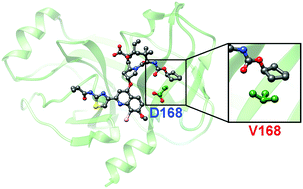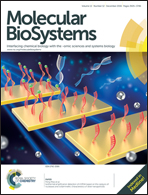Effect of D168V mutation in NS3/4A HCV protease on susceptibilities of faldaprevir and danoprevir†
Abstract
Hepatitis C virus (HCV) is a serious cause of liver inflammation, cirrhosis and the development of hepatocellular carcinoma. Its NS3/4A serine protease functions to cleave a specific peptide bond, which is an important step in HCV replication. Thus the NS3/4A protease has become one of the main drug-targets in the design and development of anti-HCV agents. Unfortunately, high mutation rates in HCV have been reported due to the lack of RNA proofreading activity resulting in drug resistance. Herein, all-atom molecular dynamics simulations were employed to understand and illustrate the effects of the NS3/4A D168V mutation on faldaprevir (FDV) and danoprevir (DNV) binding efficiency. The D168V mutation was shown to interrupt the hydrogen bonding network of Q80⋯R155⋯D168⋯R123 embedded in the extended S2 and partial S4 subsites of the NS3 protein and as a result the R123 side chain was displaced and moved out from the binding pocket. By means of MM/PBSA and MM/GBSA binding free energy calculations, the FDV and DNV binding affinities were shown to be significantly reduced by ∼10–15 kcal mol−1 and ∼4–9 kcal mol−1 relative to the wild-type complexes, respectively, which somewhat agrees with the experimental resistance folds.


 Please wait while we load your content...
Please wait while we load your content...